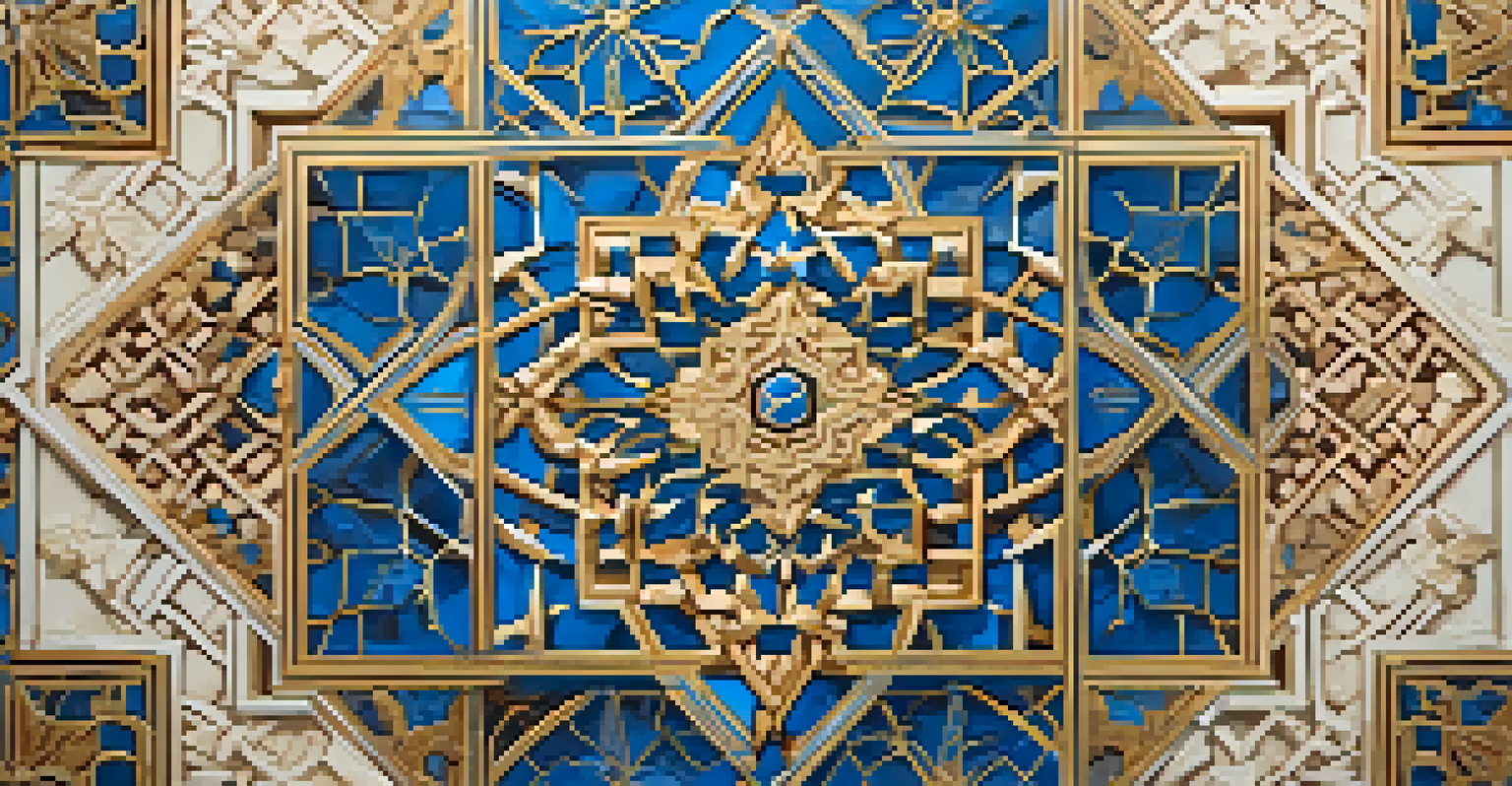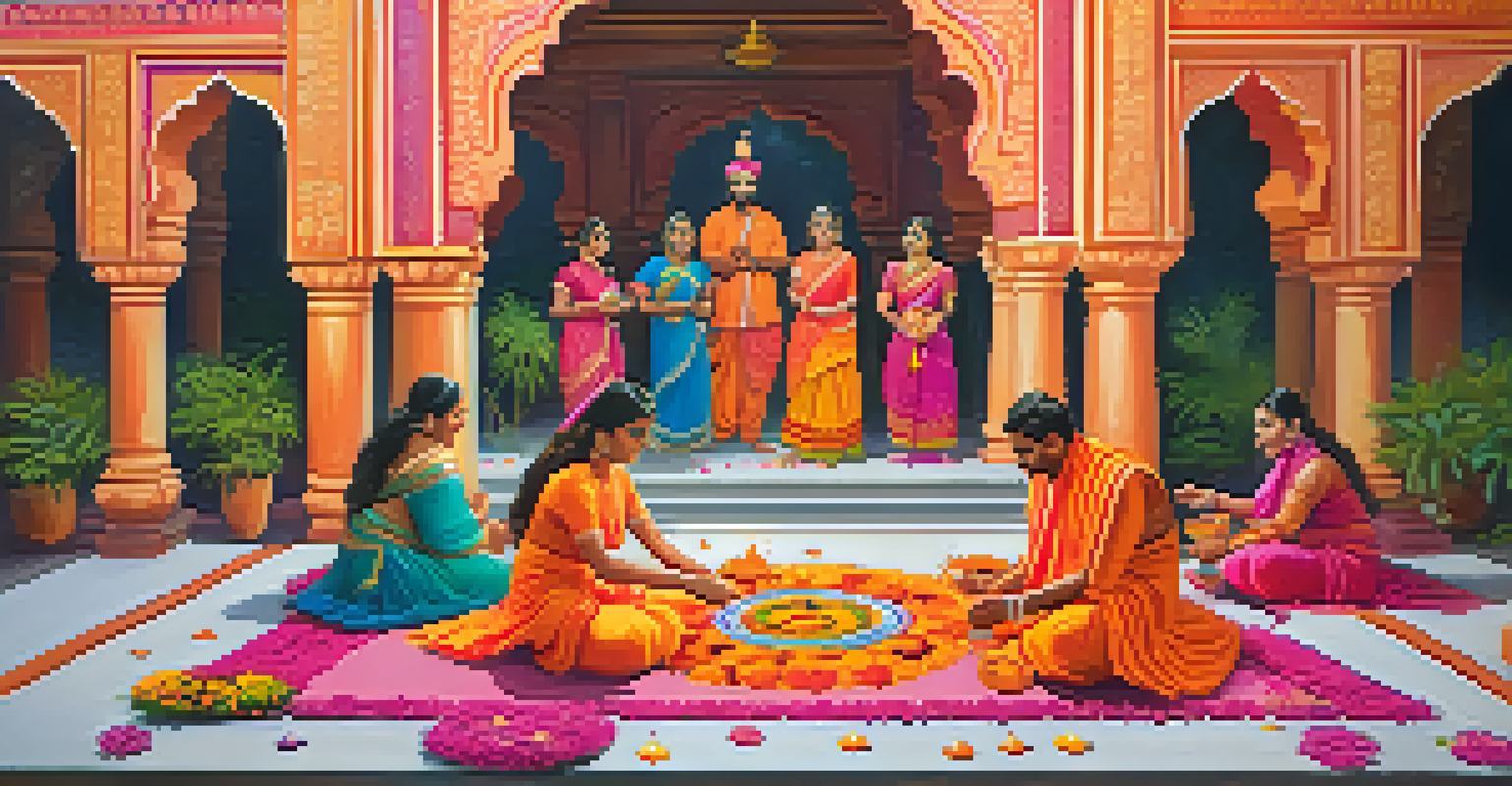Religious Influences on Painting Styles Across Cultures

The Role of Religion in Artistic Expression
Religion has long been a powerful force in shaping artistic expression. From ancient times to modern art, belief systems have influenced how artists convey their messages. Whether through divine inspiration or community expectations, religious themes are often at the forefront of many masterpieces.
Art is the most beautiful of all lies.
In many cultures, art is not just an aesthetic choice but a spiritual obligation. For instance, in Islamic art, the prohibition against depicting living beings has led to the development of intricate geometric patterns and calligraphy. This unique approach highlights how religion can guide artistic styles in distinctive ways.
The intersection of faith and art can also foster cultural identity. Artists often draw upon their religious backgrounds to create works that resonate with their communities, providing a sense of belonging and continuity. This connection between faith and artistry enriches both the artist's experience and the audience's understanding.
Christianity's Impact on European Art
Christianity has played a pivotal role in shaping European art, particularly during the Renaissance. Iconic figures such as Michelangelo and Raphael created stunning works that were deeply rooted in biblical narratives. These artists used their talents to express their faith, making religious themes accessible to the masses.

The use of light and shadow, known as chiaroscuro, became a hallmark of this period, symbolizing the divine presence in everyday life. Moreover, the emergence of perspective in painting allowed artists to create more immersive religious scenes, inviting viewers to engage with the divine on a personal level.
Religion Shapes Artistic Expression
Various belief systems significantly influence the styles and themes of artists, creating a rich tapestry of cultural identity.
Churches and cathedrals became not just places of worship, but also grand galleries showcasing religious artworks. This transformation solidified the relationship between religion and art, emphasizing the importance of spirituality in the creative process and the impact it had on society as a whole.
Buddhism and the Aesthetics of Serenity
Buddhism offers a unique perspective on art, focusing on serenity and enlightenment. Traditional Buddhist paintings often depict serene landscapes and meditative figures, reflecting the core principles of mindfulness and inner peace. This emphasis on tranquility is intended to inspire viewers to contemplate their own spiritual journeys.
Every artist dips his brush in his own soul, and paints his own nature into his pictures.
The use of symbols, such as the lotus flower and mandalas, further enhances the visual language of Buddhist art. These symbols carry deep meanings, representing purity and the cyclical nature of life. As a result, each piece serves as a visual meditation, guiding the viewer toward deeper understanding and reflection.
In contemporary art, these traditional themes continue to influence artists and resonate with a modern audience. By blending ancient techniques with contemporary styles, artists are able to communicate timeless spiritual messages, showing that the essence of Buddhist art remains relevant in today’s fast-paced world.
Hinduism's Vibrant Narrative in Art
Hinduism, with its rich tapestry of deities and stories, has a profound influence on Indian art. Vibrant colors and intricate details characterize paintings that depict mythological tales, inviting viewers into a world of divine narratives. This storytelling aspect is crucial, as it serves to educate and engage the community.
Temples often serve as canvas for these artistic expressions, with frescoes and sculptures that narrate the lives of gods and goddesses. Such works not only beautify sacred spaces but also play a vital role in rituals and worship, merging art with spirituality.
Spirituality in Contemporary Art
Modern artists explore spirituality through innovative forms, inviting audiences to engage with personal beliefs and cultural backgrounds.
The celebration of festivals like Diwali and Navaratri also brings Hindu art to life, as artists create temporary installations that reflect the joy of these occasions. This dynamic relationship between religion and art fosters a sense of belonging and cultural pride, ensuring that these traditions are passed down through generations.
Islamic Art: Unity in Diversity
Islamic art is a fascinating study of unity in diversity, characterized by its intricate geometric designs and calligraphy. With a focus on abstraction and pattern, Islamic artists have crafted stunning works that reflect the beauty of creation without depicting living beings. This unique approach stems from religious beliefs that prioritize the divine over the material.
The art of calligraphy, in particular, holds a sacred place in Islamic culture. It is often used to transcribe verses from the Quran, transforming words into visual art that carries spiritual significance. This practice not only preserves religious texts but also elevates the act of writing to an art form.
As Islamic culture spread across various regions, it absorbed local influences while maintaining its core principles. The result is a rich mosaic of styles that range from the ornate tile work of Spain to the minimalistic elegance of Persian art, showcasing how religion can adapt and thrive in diverse environments.
Indigenous Spirituality and Artistic Heritage
Indigenous cultures around the world often incorporate spiritual beliefs into their art, creating a rich tapestry of meaning and tradition. From totem poles in North America to Aboriginal dot paintings in Australia, these artworks serve as vessels for storytelling and cultural expression. They often embody the beliefs, histories, and worldviews of their creators.
Nature plays a central role in many indigenous artistic expressions, reflecting a deep connection to the land and its resources. For instance, the use of natural pigments in paintings not only connects the artwork to the environment but also honors the spiritual relationship indigenous peoples have with their surroundings.
Cultural Heritage in Indigenous Art
Indigenous art reflects deep spiritual connections to nature and tradition, serving as a vital expression of identity and history.
The preservation of these artistic traditions is crucial for maintaining cultural identity. As globalization threatens to overshadow local practices, many indigenous artists are embracing their heritage while also innovating new forms of expression, ensuring that their spiritual narratives continue to resonate in a modern context.
Modern Spirituality in Contemporary Art
In contemporary art, the influence of spirituality remains strong, often manifesting in innovative ways. Artists today explore themes of spirituality, questioning traditional beliefs and seeking new forms of expression. This evolution reflects the diverse spiritual landscapes of our global society, where personal beliefs are increasingly individualistic.
Installation art, for example, often invites viewers to engage with spiritual concepts in immersive environments. By creating spaces that encourage reflection and introspection, artists challenge audiences to consider their own beliefs and experiences. This interactive approach to spirituality helps bridge the gap between the viewer and the artwork.

Furthermore, many contemporary artists draw inspiration from their cultural backgrounds, merging traditional practices with modern techniques. This fusion not only celebrates the past but also redefines what spirituality means in today’s world, allowing for a richer, more inclusive dialogue between art and faith.